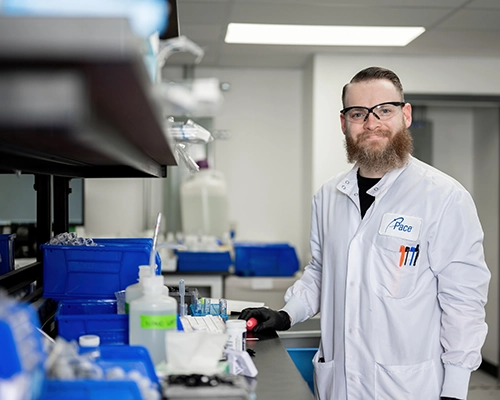Your Trusted Partner for Leaching Environmental Assessment Framework (LEAF) Testing and Analysis
Pace® has provided Leaching Environmental Assessment Framework (LEAF) testing and analysis since 2011 as well as other leaching, accelerated weathering and kinetic testing. We use state-of-the-art laboratory equipment and industry-approved methodologies to ensure accurate and reliable results so you can quickly make decisions and confidently comply with regulatory requirements.
What is a Leaching Assessment?
Leaching can cause constituents of potential concern (COPCs) to migrate from solid materials into surrounding soils, groundwater, or surface water. A leaching assessment estimates the extent and rate of this COPC release through waterborne pathways. It can also provide insights into a material’s durability under environmental conditions, based on the dissolution and transport of its primary constituents.
Laboratory leaching tests form the basis for estimating which constituents will leach, at what rate, and what factors control the leaching process. The data from these tests can be used to develop a quantitative description of a material’s leaching behavior – a “leaching source term” that represents COPC release under defined management scenarios.
LEAF Services Summary
The LEAF Methods have been designed to consider the effect of key environmental conditions and waste properties on leaching. LEAF method results can be used to develop screening level assessments of constituent release or to develop more accurate estimates of release in specific use or disposal scenarios.
Pace® Analytical commercially supports all four EPA LEAF methods.
Services Summary Method 1313 is designed to evaluate the partitioning of constituents between liquid and solid phases at or near equilibrium conditions over a wide range of pH values. The method consists of 9-10 parallel batch extractions of solid material at various target pH values.
Services Summary Method 1314 is a percolation column test designed to evaluate constituent releases from solid materials as a function of cumulative liquid-to-solid ratio. The method consists of a column packed with granular material with moderate compaction. Eluent is pumped up through the column to minimize air entrainment and preferential flow.
Services Summary Method 1315 is a semi-dynamic tank leaching procedure used to determine the rate of mass transport from either monolithic materials (e.g., concrete materials, bricks, tiles) or compacted granular materials (e.g., soils, sediments, fly ash) as a function of time using deionized water as the leaching solution. The method consists of leaching a sample in a bath with periodic renewal of the leaching solution at specified cumulative leaching times.
Services Summary Method 1316 is an equilibrium-based leaching test intended to provide eluate solutions over a range of liquid-to-solid ratios. This method consists of five parallel batch extractions of a particle-size-reduced solid material in reagent water over a range of liquid-to-solid ratios. At the end of the contact interval, the liquid and solid phases are separated for constituent analysis.

A Nationally Recognized Leader for LEAF Testing
Having experience and expertise in LEAF testing and analysis can make all the difference. As the largest American-owned lab, we are committed to providing accurate and reliable testing services. The experts at Pace® have the knowledge and experience to assist you in identifying the most appropriate and cost-effective sampling plan for your project.